When you think about SEO, it’s easy to focus on keyword research, backlinks, and content production.
But at the root of it all, SEO is about connecting your business with customers.
And behind every Google or Bing search is a real person hoping your business can help them solve a problem.
For your SEO strategy to succeed, the people at the other end of a search — your potential customers — need to be your focus.
In this guide, we’ll show you how to create search personas to ensure your SEO strategy helps you connect with the right people.
Let’s get started…
%(tableofcontents)
What Are Search Personas?
Personas are examples of typical customers of your business. They can help you understand customers and potential customers so you can create SEO-focused content to match their needs and solve their problems.
Every business has a target customer. And with a persona, the goal is to learn about whom you serve, how they make decisions, and why they make those decisions.
For example, if you’re a software company selling to ecommerce brands:
- Who in the company uses your software?
- Why did they make purchase decisions?
- Why did they make those decisions? What makes them convinced they need your software?
How are search personas used?
Search personas can help your business by:
- Helping you focus on who you’re connecting with over search
- Creating specific, useful content for your customers
- Improving the quality of your leads coming from search
So… how do you create search personas for your business? Here's how in three steps.
Step 1: Understand Your Customers
The best way to create search personas for your business is to study your customers/target customers and uncover insights about their workflows and day-to-day challenges.
Here are two approaches I’ve used to learn about customers create user personas:
1. Customer Research Calls
I speak directly to my current and potential customers to get first-hand information from the people my company targets.
By calling a customer, you can get to know their business, their role within the team, their day-to-day responsibilities, and how your product solves their problems.
To prioritize calls, find engaged customers who use your product more than average — these are the types of customers you want to attract to your business, so aim to learn from the people who get the most value from your product.
With outreach, keep your message short and simple:
Hi Name,
I work for [your company name] and noticed you’ve seen a lot of success with our product recently!
I’m trying to learn more about how people in your role measure success and would love to chat.
Would you be interested in a 30-minute interview? It'd be a totally casual conversation — I'm hoping to ask a few simple questions and learn how you approach [discipline/problem].
Do you have time to chat early next week?
Thanks,
Name
If this doesn’t work, it can help to offer compensation for their time. A few options include:
- Pay for 30 minutes of their time
- Offer gift vouchers (e.g. $20 on Amazon or Starbucks)
- Give product discounts
Here’s an example outreach email with an offer:
Hi Name,
I work for [your company name] and I've been connecting with [role title e.g., digital marketers] to learn their approach to [discipline/problem e.g., running Facebook ads campaigns].
I discovered [their company name] and you're in just the type of role [e.g. marketer] I'm looking to speak with.
Would you be interested in a 30-minute interview? It'd be a totally casual conversation — I'm hoping to ask a few simple questions and learn how you approach [discipline/problem].
As a small thank you, I'm offering $20 (or $20 in gift cards) for your time and assistance.
Do you have time to chat early next week?
Thanks,
Name
Once you have a few customer interviews lined up, prepare questions that will help you uncover vital details for your search personas. For example:
- What’s the hardest part of your job?
- How do you know you’re successful in your job?
- Where do you go to learn new skills for your role?
2. Study Target Customers On LinkedIn
LinkedIn is a goldmine for company data.
By searching for a business on LinkedIn, you can begin to map out their teams and the types of roles in the company. This will help you uncover types of people your business should target with SEO content.
Say you run a software business and you want to connect with marketers at ecommerce companies. Go to LinkedIn, write a target company in the search bar, and click their company profile in the results:
(I’ll use Leesa Sleep for this example.)

Next, click the People tab of the profile:
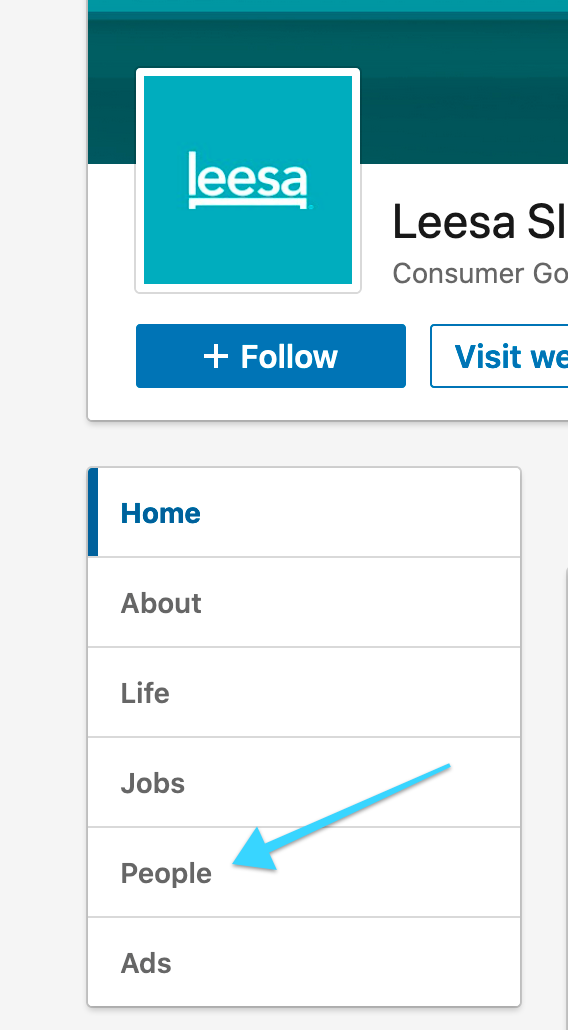
And then search for keywords related to your target customers (e.g., marketing):
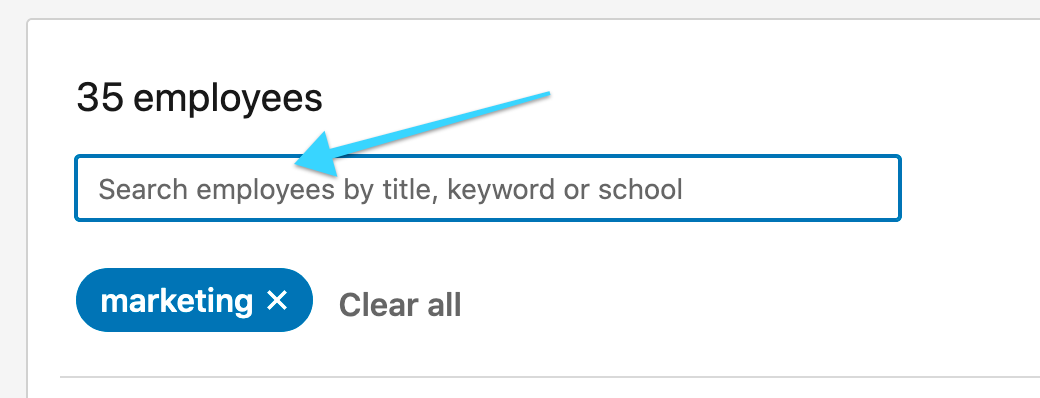
Now, you’ll see people who work at that company and in your chosen department. From here you, can explore profiles of people whose roles best match your customers:
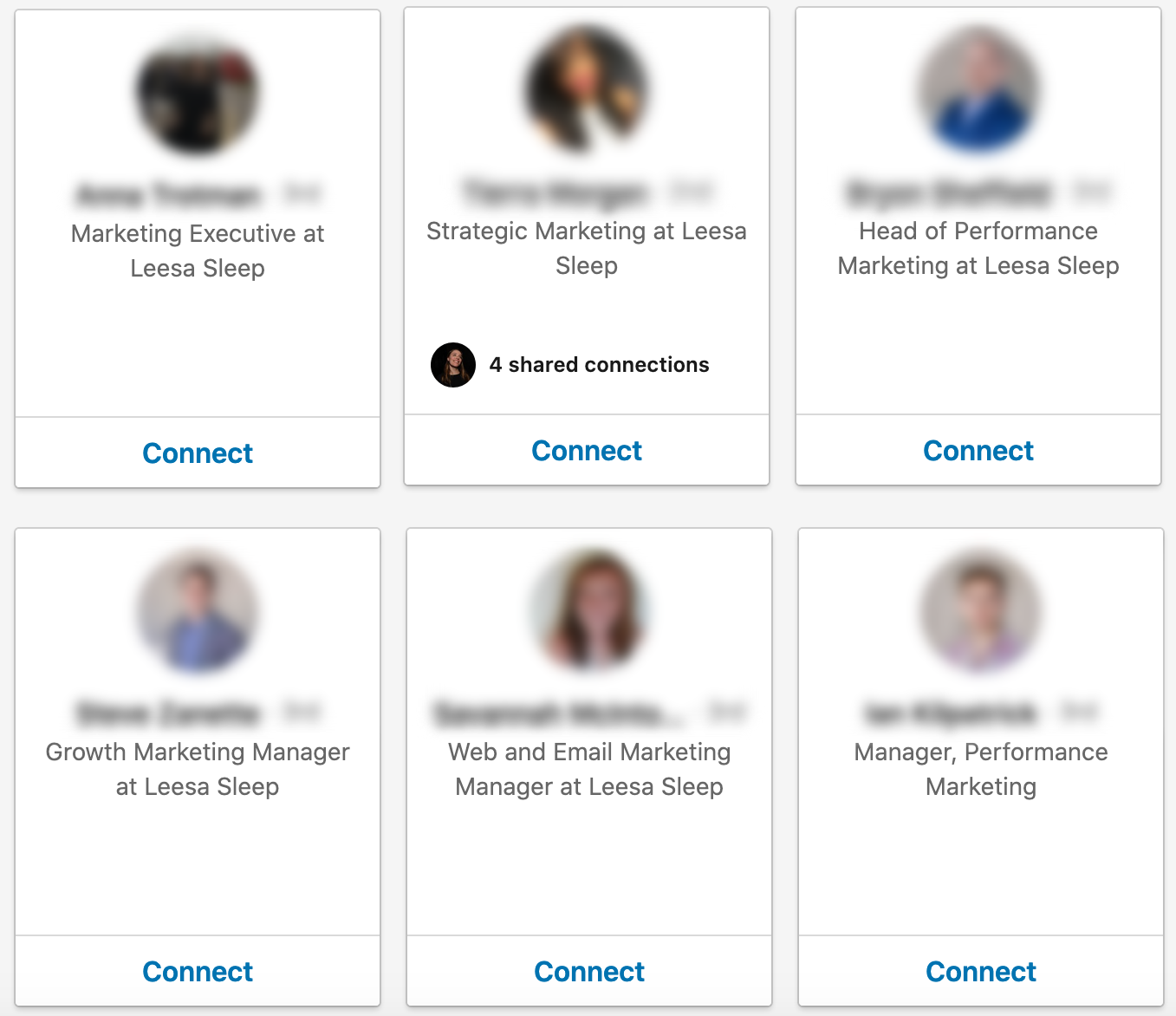
Next, view the profiles of people who are most relevant to your business and see how they describe their current role. What are they responsible for? How do they measure success?
For example:
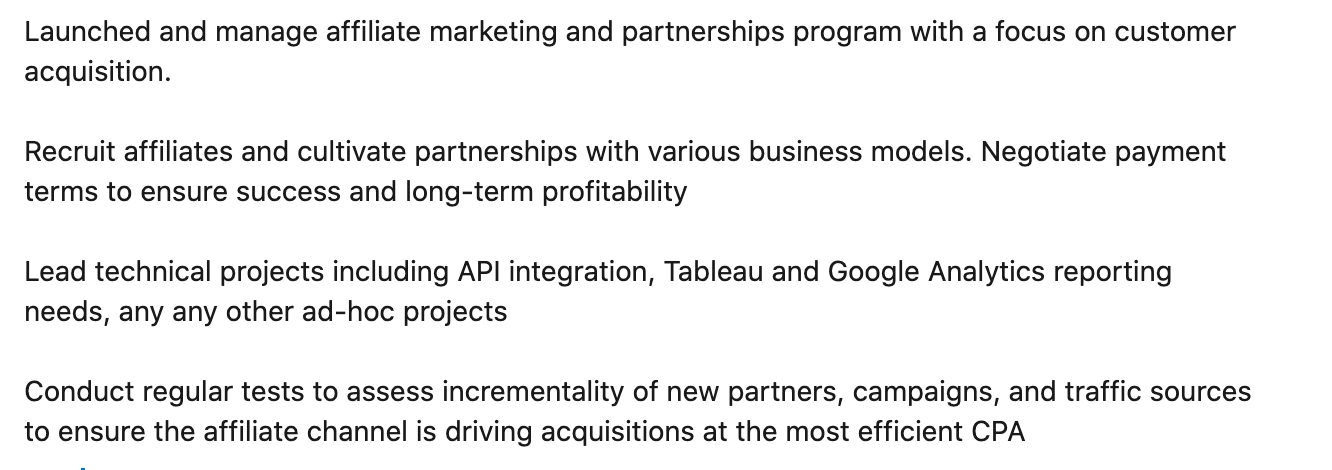
(Not everyone goes into great detail on their profile so you might need to view a few until you find what you’re looking for.)
Additional Research Opportunities
Customer research calls and LinkedIn are two ways to learn more about your customers and create search personas for your brand. Here are three additional ways to uncover insights:
-
Talk to your support team: Support staff interact with your customers daily. They know the problems your customers face, and why they turn to your business. Speak to your support team to understand more about the types of customers that have the most success with your business and to learn more about their personas.
-
Find common questions and objections: If you have a sales team, check in with them to see the questions people ask or the objections they share during the sales process. This will help you identify keywords and topics you could create content around. It’ll also help you understand which types of customers contact your business.
-
Review social mentions: People are likely talking about your brand (or competitors) on social media channels. Search for your brand mentions to see what people are talking about and see the types of people interested in your product/service and others like it.
What To Look Out For
As you research your user personas, pay attention to a few key details to help your business create search content that appeals to and solves problems for your target customers.
Specifically, you want to focus on learning:
-
Role: What job titles do they use?
-
Tasks: What does their day-to-day schedule look like? Where does your business fit into this routine?
-
Goals: What are they trying to achieve? How do they measure it?
-
Challenges: What problems hold them back from achieving their goals?
Make sure to take detailed notes on each point from your findings on LinkedIn and customer research calls. These notes will help you create your search personas.
Aim to research 10-15 target companies to get a real sense of the types of people your business is ultimately selling to… and trying to connect with through search.
2. Create Your Search Personas
Okay, you’ve researched a bunch of target companies, and you should have some clear notes and takeaways on who you’re marketing to.
It's time to collate all the information you’ve uncovered into one document, then group your findings based on the four areas I mentioned above:
-
Role: What job titles do they use?
-
Tasks: What does their day-to-day schedule look like? Where does your business fit into this routine?
-
Goals: What are they trying to achieve? How do they measure it?
-
Challenges: What problems hold them back from achieving their goals?
For example, under Role, list all the job titles of people you spoke to and discovered on LinkedIn, like.:
- Social media marketer
- Digital marketer
- Social content producer
The goal is to list your findings and find commonalities across everyone you have researched.
Once everything is laid out, create one or two personas based on your learnings. I like to write them in first-person (this isn’t essential, but I find it really helps me step into their shoes).
Here are two personas we focus on at Buffer:
Social Media Specialist
About Me
- I manage all of our social media platforms, putting out content and engaging with customers.
- I'm a heavy user of all Buffer products.
- I spend most of my day in social media and content creation tools like Buffer and Canva.
- I love listening to podcasts and reading email newsletters on a variety of topics.
- I love the freedom my job affords me, but I'm overworked and struggle for time.
- My top priorities at work are that I have an ongoing supply and plan for delivering content to our social audience and that I respond to our customer queries fast.
- I get frustrated by social platforms… it's getting harder and harder to generate engagement and build a social community without relying on advertising.
Content and Creative Manager
About Me
- I manage our editorial content, making sure we deliver high-quality creative and showcase our products in their best light.
- I'm currently paying for a social media management tool, but I mainly use it to check in on how our content is performing and whether our audience is growing.
- I'm very focused on trends in my industry vertical and read a lot of publications and newsletters.
- I spend most of my day strategizing and managing our content campaigns.
- My top two priorities are tying content and brand metrics to ROI for our business and delivering high-quality brand experiences through our content.
- One of my big challenges is finding new ways to help us stand out in an increasingly commoditized and competitive space.
Once you have your personas ready… it’s time to think about how you can reach then via search.
3. Identify Keyword Opportunities To Solve Their Problems
We know who we’re writing for and have our search personas set. Now, we need to find some keywords to help us connect with them.
The first step is to uncover relevant keywords for your business. To do this, I like to use Ahrefs, but tools like Moz and KWFinder can help too.
But we’re not just doing generic keyword research here.
How To Apply Personas To Keyword Research
To uncover keywords that will make an impact for your business, look at what you found that relates to your target customers Tasks, Goals, and Challenges:
-
Tasks: What does their day-to-day schedule look like? Where does your business fit into this routine?
-
Goals: What are they trying to achieve? How do they measure it?
-
Challenges: What problems hold them back from achieving their goals?
For example, taking the Social Media Specialist persona from above, I see one challenge is: “I get frustrated by social platforms… it's getting harder and harder to generate engagement and build a social community without relying on advertising.”
From this statement, I can start to research keywords around:
- Building social media communities
- Social media engagement
- Organic growth
- Social platform changes/updates
Try to list 4-5 keyword ideas relating to each task, goal, and challenge your personas have, and you’ll soon have plenty of highly relevant phrases to dive into.
Next, run these keywords and phrases through your SEO tool to uncover peoples' searches and other related keywords.
Then, create a simple spreadsheet for each of the keywords you want to focus on. Include:
- Keyword you’re targeting
- Which persona it’s for
- The search intent/pain point that content should solve
(That third one is super important; when you create content for your search personas, every piece should match the searcher's intent and help them solve a specific problem.)
Enhance Your SEO Strategy Today
If you want your SEO strategy to be truly successful, you HAVE to understand the people behind your target keywords.
Creating search personas is the BEST way to do this. Personas give you a clear focus on who you’re writing for and enable you to create content that solves the problems that impact the day-to-day lives of your customers and target customers.
And it’s as easy as 1-2-3. Remember:
- Understand your customers
- Create your search personas
- Identify keyword opportunities
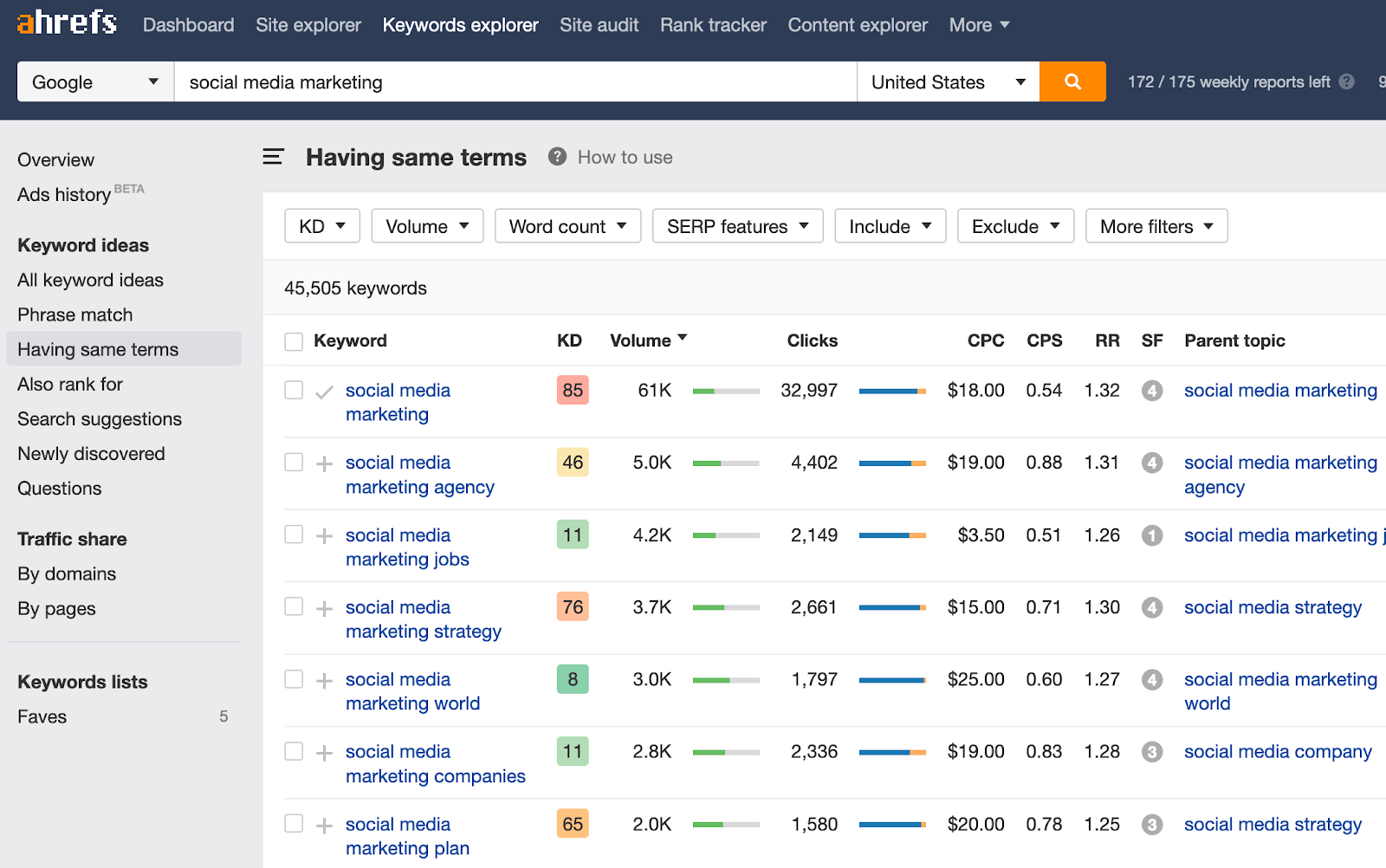










Add A Comment
VIEW THE COMMENTS